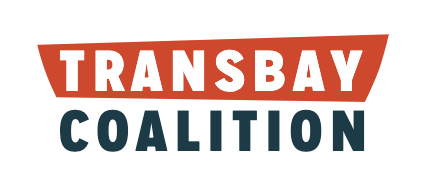Clipper BayPass – the Bay Area’s successful all-agency transit pass pilot – is taking an important step forward, expanding from the first set of institutional customers – public colleges/universities and affordable housing communities – to employers by the end of this year.
The program’s first phase is showing impressive results – users with the all-agency BayPass show a 35% increase in transit ridership – taking over 2 million trips – with many happy individual customers such as Thelma Eally, a resident of a senior affordable housing community in Colma, and Ri Bussey, a student at Santa Rosa Junior College who can go to work and school. (see this inspirational video).
Transit riders use the all-agency Clipper Bay Pass for more mobility
Clipper BayPass Phase 2 – expanding to employers and workers
The second phase of the pilot is intended to reach about ten employers around the region, and up to 20,000 riders over the next two years, and test the opportunity to increase transit ridership further. At the Fare Integration Task Force, transit general managers reviewed and approved the structure of the pilot.
All of the General Managers were in support, with Bob Powers of BART particularly enthusiastic. This represents a major turnaround for BART, which before the pandemic was leery of fare integration, concerned that it would take away from fare income, which was a major source before the pandemic, generating about 70% of BART’s revenue.
However, agencies that already had single-agency pass programs are nervous that they might see less revenue – even though an all-agency pass will appeal to many more customers. Think about an employer in downtown San Francisco or San Jose. Their workers travel in many directions, so they would benefit most from a pass that enables more employees to commute from where they live.
As with the first phase, the pilot will be available to any existing employer and institutional customer as an upgrade to their Preexisting Institutional Pass. To alleviate the risk of undercutting existing pass revenue, the pilot has a condition that “Clipper BayPass will not be offered at a price that undercuts the cost of any Preexisting Institutional Pass Product.”
To help bring back employers who allowed their subscriptions to lapse in the depths of the pandemic, the “existing customer” is defined as a subscriber to an institutional program pass program as of January 1, 2020.
Alleviating risk of revenue loss – and leaving out opportunity to increase ridership
But the second phase of the program is missing out on some important opportunities to increase transit ridership.
The agency that is the most concerned about revenue loss is Caltrain – since about a third of Caltrain’s fare revenue has been generated by the GoPass single-agency pass, before the pandemic and still today.
Caltrain’s concern isn’t imaginary, because the revenue model of the BayPass pilot is very different from the GoPass. With the GoPass, employers pay a flat rate per worker for all workers at the site, at a price per employee that is much lower than a retail pass. Caltrain pockets all the revenue, even if a relatively small share of employees use Caltrain.
With the BayPass pilot, MTC will pay agencies based on the amount of trips that employees actually take at a rate equal to a regular adult Clipper Fare. Caltrain estimates that this reimbursement formula would generate much less revenue to the agency.
According to the terms of the pilot, MTC and BART (who are jointly administering the program) will take only up to $1 million to reimburse administration costs. BUT the remaining additional revenue “will be allocated to transit operators based on each operator’s share of overall Phase 2 ridership.” Because Caltrain’s ridership is lower than BART and Muni, what this would do, in effect, would be to redistribute revenue to larger operators.
Because of the condition of the pilot not to undercut pricing for existing pass customers, the risk of undercutting GoPass revenue only applies to customers that are new to Caltrain. The deeply problematic solution – avoid new customers.
To alleviate risk to Caltrain, the terms of the Phase 2 pilot state that “In San Mateo County and Santa Clara County, Clipper BayPass will only be offered to Preexisting Institutional Pass Product customers of Caltrain’s GoPass Program within three miles of a Caltrain rail station OR VTA’s SmartPass Program outside of three miles of a Caltrain rail station.”
Excluding San Jose service workers
Unfortunately, this condition excludes some attractive opportunities to increase transit ridership – for Caltrain and for the South Bay. The three mile “Caltrain exclusion zone” leaves out about three thousand workers at San Jose Mineta Airport which has been one of the flagship customers of VTA’s SmartPass. It also leaves out many workers at hotels near the airport and downtown San Jose which have been notable SmartPass customers. It also leaves out workers at San Jose City Hall.
In recent years starting before the pandemic, Palo Alto’s Transportation Management Association found that a significant number of hotel, retail and restaurant service workers do use Caltrain when they are provided affordable access through the TMA. In 2019, PATMA shifted over 300 downtown service workers away from driving, and their most popular offering was Caltrain access. This result disproved the conventional wisdom that retail and hospitality workers prefer bus or driving and lack interest in rail.
Enabling San Jose’s airport, hotel, and other service workers to gain access to Caltrain and BART would be a strong equity measure for lower-income service workers. It would allow the pilot to test a hypothesis that in San Jose – as in Palo Alto – a notable number of service workers will shift to transit including rail when they have convenient, affordable access.
By selling BayPass only to existing GoPass customers – not VTA SmartPass customers that are new to Caltrain – the pilot program is setting up for a result where Caltrain shows relatively little ridership growth from the program. Caltrain, with ridership at 30% of pre-pandemic level – is in dire need of ridership increase.
Caltrain doubles down on single-agency GoPass
Meanwhile, in its fare and ridership regrowth strategies, Caltrain is doubling down on expanding use of the single agency GoPass, for example proposing new lower price points to appeal to educational institutions and affordable housing developments.
For the upcoming year this isn’t wrong – the BayPass pilot is limited in size, and it won’t be available to customers that don’t already have an institutional pass. So Caltrain is right to assertively pursue new customers.
BUT – looking to the future, an affordable housing development or a community college would reasonably prefer an all-agency pass to a single agency pass. Residents and students will want the ability to take buses and BART, not just Caltrain. When approving a new housing development, cities will of course prefer an all-agency pass than a (paradoxical) decision about whether to offer a local bus pass OR a Caltrain pass OR a transbay bus pass.
But when presenting its fare strategy to its board, Caltrain staff describes the GoPass as though a single agency pass was still the future, rather than the multi-agency passes that make the most sense for customers.
Revenue-sharing: a gnarly math problem that needs to be solved
The question of how to structure the multi-agency BayPass with pricing that will provide value to institutional customers – with a revenue sharing mechanism that will support the budgets of transit service providers – is a gnarly math problem. This first round doesn’t have the math problem fully solved. Given the existential need to regrow ridership, it is critical that MTC and Bay Area transit agencies continue to work together in good faith to work out better solutions.
The nervousness of Caltrain and other agencies with existing programs can be seen in the provision that “Any agency will have the discretion to participate or not participate in any future post-pilot Clipper BayPass program that may be established.” This condition is a clear indication of the weakness of the region’s “Network Management” system, where initiatives to coordinate among the 27 transit agencies are fragile and can unravel at any moment.
The Bay Area transit system is in dire straits. Ridership has slowly recovered past 50% of pre-pandemic levels. Caltrain’s ridership is around 30% of pre-pandemic levels And yet, agencies seem more strongly focused on fearing revenue loss, rather than on solving the revenue sharing and backup funding math problems in order to increase ridership by offering a more attractive product to institutional customers.
Community colleges, affordable housing and the potential role of public funding
Meanwhile, at board and advisory group meetings, other potential customers are eager for an even broader rollout of the BayPass. In particular, many community colleges that don’t yet have any transit passes are impatient at not being included, because these institutions cannot afford a pass program to begin with.
BayPass program staff say that their goal is to have a program that is “revenue neutral.” However, as the region starts to plan for a 2026 funding measure that will include funding for a more convenient, integrated system, we wonder if it will be helpful to include funding to support passes for low-budget institutions such as community colleges and affordable housing developments – or whether there might be other sources of public funding to meet these needs.

